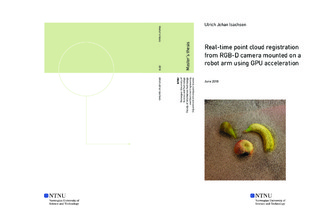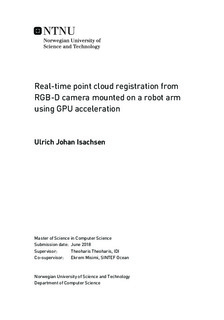| dc.description.abstract | Recent development of 3D scanners have provided small, precise and cheap consumer grade scanners operating in real-time. Especially because of their low weight, they are being considered for usage in visual servoing (vision aided robot control). These 3D scanners take images that are represented as an unstructured list of points represented by their position in 3D space and color called point clouds. The goal of this project has been to perform real-time point cloud registration using Graphics Processing Unit (GPU) acceleration (Registration is the task of aligning separate 3D scans into a single point cloud that minimize the distance between common features in the point clouds) for a camera mounted in an eye-in-hand configuration to perform scans of food and food-like objects. This is different from a lot of previous work that look at room scale scans.
This thesis is based on state of the art algorithms for GPU accelerated point to point based registration and extended this with a point to plane linear least squares optimizer, which is one of the novel contributions of this thesis. This also involved an implementation of a kD-tree search algorithm on the GPU. The point-to-plane optimizer is compared to a recent grid based registration algorithm that is also extended with a pre-search strategy and a multi-resolution search. In this project, a new point correspondence rejector based on a boundary rejection strategy that improves registration quality was evaluated, showing that it could greatly improve registration quality. Apart from the specific implementations, one of the main contributions of this master thesis is the use of a Relative Pose Error (RPE) based error metric to evaluate algorithms that are conceptually different.
Both performance and registration correctness has been evaluated for the GPU implementations of the 3D registration methods in this thesis, showing that real-time point to point based registration is possible for high resolution point clouds without noticeable loss of registration correctness. The GPU implementations performed are 33 times faster than similar CPU implementations and 8 times faster than the PCL-based CPU implementations. The point to plane linear least squares optimizer was proven to perform well both performance wise and correctness wise. The grid based search with its suggested improvements was observed to be fast, but didn't match the quality of the point to point based algorithms on the GPU. The algorithm correctness was evaluated using a reference trajectory generated with the robot arm. The point to point distance evaluation strategy that is typically used when evaluating registration algorithms is in this work shown to be insufficient to compare different algorithms to each other, in which the reference path strategy is an external evaluation that is shown to be an efficient metric when comparing different algorithms to each other. The 3D registration methods and implementations used in this thesis are evaluated against a number of rigid and non-rigid properties varying textural and optical properties.
This thesis is based on state of the art algorithms for GPU accelerated point to point based registration and extended this with a point to plane linear least squares optimizer (which has also involved an implementation of a kD-tree search algorithm on the GPU). This is compared to a recent grid based registration algorithm that is also extended with a pre-search strategy and a multi-resolution search. In this project, a new point correspondence rejector based on a boundary rejection strategy that improves registration quality was evaluated, showing that it could greatly improve registration quality.
Both performance and registration correctness has been evaluated for the implementations, showing that real-time point to point based registration is possible for high resolution point clouds without noticeable loss of registration correctness. The GPU implementations performed are 33 times faster than similar CPU implementations and 8 times faster than the PCL CPU implementations. The point to plane linear least squares optimizer was proven to perform well both performance wise and correctness wise. The grid based search with it's suggested improvements was observed to be fast, but didn't match the quality of the point to point based algorithms on the GPU. The algorithm correctness was evaluated using a reference trajectory generated with the robot arm. The point to point distance evaluation strategy that is typically used when evaluating registration algorithms is in this work shown to be insufficient to compare different algorithms to each other, in which the reference path strategy is an external evaluation that is shown to be an efficient metric when comparing different algorithms to each other. | en |

